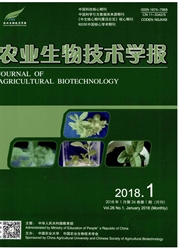

 中文摘要:
中文摘要:
雌激素受体(estrogen receptor,ESR)与雌激素专一性地结合,并通过与雌激素的相互作用来调节生殖机能相关基因的表达,在动物繁殖中起着重要作用。研究采用PCR-SSCP和测序方法分析ESR基因外显子1、4在部分山羊(Capra hircus)品种中的单核苷酸多态性,并研究该基因对山羊繁殖力的影响。结果表明:ESR基因外显子1、4在所检测的济宁青山羊、波尔山羊、安哥拉山羊和内蒙古绒山羊中均不存在多态性;山羊扩增片段核苷酸和氨基酸序列与人、牛、猪、马、绵羊、大鼠、小鼠和鸡8个物种的同源性分别为51.3%-97.3%和64.5%-98.3%;山羊ESR基因氨基酸序列存在2处特有突变,分别是外显子1第81位插入一个脯氨酸(P)和外显子4第4位由天冬氨酸突变为天冬酰胺(D4N)。哺乳动物ESR基因外显子1、4序列保守性强,该区域可能不是影响山羊高繁殖力的功能结构域。
 英文摘要:
英文摘要:
The estrogen receptor (ESR) plays an important role in animal reproduction through binding specifically with estrogen and interacting with estrogen to regulate the expression of related genes of reproductive function, and was studied as a candidate gene for prolificacy in some goat (Capra hircus) breeds. Single nucleotide polymorphisms (SNPs) ofexons 1 and 4 ofESR gene were detected in high prolificacy breed (Jining Grey goat), moderate prolificacy breed (Boer goat) and low prolificacy breeds (Inner Mongolia Cashmere and Angora goats) by polymerase chain reaction-single strand conformation polymorphism (PCR-SSCP). Results showed that no polymorphism was detected in the amplified region in the four goat breeds tested. The nucleotide sequences of these two fragments were detected and the corresponding amino acid sequences were deduced. The comparison of the fragments ofexons 1 and 4 of goat ESR gene with those of human, cattle, pig, horse, sheep, rat, mouse and chicken ESR gene showed that the homologies of the nucleotide sequences and amino acid sequences of the fragments with these eight species were from 51.3% to 97.3% and from 64.5% to 98.3% respectively. Two special variations were found in amino acid sequence ofgoats, which were 81st (prolineinsertion) inexon 1 and 4th (D4N) in exon 4. The results indicated that the ESR gene was highly conserved among mammals, and exons 1 and 4 may not be the functional domains that affect the high prolificacy in goats.
 同期刊论文项目
同期刊论文项目
 同项目期刊论文
同项目期刊论文
 期刊信息
期刊信息
